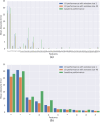Utilizing machine learning and molecular dynamics for enhanced drug delivery in nanoparticle systems
- PMID: 39496651
- PMCID: PMC11535187
- DOI: 10.1038/s41598-024-73268-0
Utilizing machine learning and molecular dynamics for enhanced drug delivery in nanoparticle systems
Abstract
Materials data science and machine learning (ML) are pivotal in advancing cancer treatment strategies beyond traditional methods like chemotherapy. Nanotherapeutics, which merge nanotechnology with targeted drug delivery, exemplify this advancement by offering improved precision and reduced side effects in cancer therapy. The development of these nanotherapeutic agents depends critically on understanding nanoparticle (NP) properties and their biological interactions, often analyzed through molecular dynamics (MD) simulations. This study enhances these analyses by integrating ML with MD simulations, significantly improving both prediction accuracy and computational efficiency. We introduce a comprehensive three-stage methodology for predicting the solvent-accessible surface area (SASA) of NPs, which is crucial for their therapeutic efficacy. The process involves training an ML model to forecast the many-body tensor representation (MBTR) for future time steps, applying data augmentation to increase dataset realism, and refining the SASA predictor with both augmented and original data. Results demonstrate that our methodology can predict SASA values 299 time steps ahead with a 40-fold speed improvement and a 25% accuracy increase over existing methods. Importantly, it provides a 300-fold increase in computational speed compared to traditional simulation techniques, offering substantial cost and time savings for nanotherapeutic research and development.
Keywords: Cancer therapy; Data augmentation; Data science; Drug delivery; Machine learning; Molecular dynamics simulations; Nanotherapeutics.
© 2024. The Author(s).
Conflict of interest statement
The authors declare no competing interests.
Figures





Similar articles
-
Predicting efficacy of drug-carrier nanoparticle designs for cancer treatment: a machine learning-based solution.Sci Rep. 2023 Jan 11;13(1):547. doi: 10.1038/s41598-023-27729-7. Sci Rep. 2023. PMID: 36631637 Free PMC article.
-
Machine learning- a new paradigm in nanoparticle-mediated drug delivery to cancerous tissues through the human cardiovascular system enhanced by magnetic field.Sci Rep. 2024 Sep 27;14(1):22048. doi: 10.1038/s41598-024-72629-z. Sci Rep. 2024. PMID: 39333571 Free PMC article.
-
A data-guided approach for the evaluation of zeolites for hydrogen storage with the aid of molecular simulations.J Mol Model. 2024 Jan 18;30(2):43. doi: 10.1007/s00894-024-05837-z. J Mol Model. 2024. PMID: 38236500
-
Toward the Integration of Machine Learning and Molecular Modeling for Designing Drug Delivery Nanocarriers.Adv Mater. 2024 Nov;36(45):e2407793. doi: 10.1002/adma.202407793. Epub 2024 Sep 10. Adv Mater. 2024. PMID: 39252670 Review.
-
Computational and Experimental Approaches to Investigate Lipid Nanoparticles as Drug and Gene Delivery Systems.Curr Top Med Chem. 2021;21(2):92-114. doi: 10.2174/1568026620666201126162945. Curr Top Med Chem. 2021. PMID: 33243123 Free PMC article. Review.
Cited by
-
Nanotechnology in Orthopedic Care: Advances in Drug Delivery, Implants, and Biocompatibility Considerations.Int J Nanomedicine. 2025 Jul 21;20:9251-9274. doi: 10.2147/IJN.S523462. eCollection 2025. Int J Nanomedicine. 2025. PMID: 40727579 Free PMC article. Review.
-
Machine learning enabled multiscale model for nanoparticle margination and physiology based pharmacokinetics.Comput Chem Eng. 2025 Jul;198:109081. doi: 10.1016/j.compchemeng.2025.109081. Epub 2025 Mar 9. Comput Chem Eng. 2025. PMID: 40657536
-
Insight into the Phase Inversion of Myristic Acid In Situ Gels for Drug Delivery Applications.ACS Omega. 2025 May 21;10(21):21432-21449. doi: 10.1021/acsomega.5c00187. eCollection 2025 Jun 3. ACS Omega. 2025. PMID: 40488091 Free PMC article.
-
Utilizing machine learning to predict MRI signal outputs from iron oxide nanoparticles through the PSLG algorithm.Sci Rep. 2025 Jul 16;15(1):25739. doi: 10.1038/s41598-025-01994-0. Sci Rep. 2025. PMID: 40670416 Free PMC article.
References
-
- Klement, R. J. Cancer as a global health crisis with deep evolutionary roots. Glob. Trans.6, 45-65. 10.1016/j.glt.2024.01.001 (2024).
-
- Sriharikrishnaa, S., Suresh, P. S. & Prasada, K. S. An introduction to fundamentals of cancer biology. in (eds Mazumder, N., Kistenev, Y. V., Borisova, E. & Prasada, K.) S. Optical Polarimetric Modalities for Biomedical Research 307-330, 10.1007/978-3-031-31852-8_11 (Springer, (2023).
-
- Tiwari, H. et al. Advancing era and rising concerns in nanotechnology-based cancer treatment. ACS Chem. Health Saf.31, 153-161. 10.1021/acs.chas.3c00104 (2024).
MeSH terms
LinkOut - more resources
Full Text Sources
Miscellaneous

